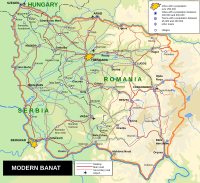
Photo from wikipedia
Abstract We provide the first high-resolution CO 2 flux data for the Neogene to Quaternary volcanic regions of the entire Carpathian-Pannonian Region, Eastern-Central Europe, and estimate the CO 2 emission… Click to show full abstract
Abstract We provide the first high-resolution CO 2 flux data for the Neogene to Quaternary volcanic regions of the entire Carpathian-Pannonian Region, Eastern-Central Europe, and estimate the CO 2 emission of the seemingly inactive Ciomadul volcanic complex, the youngest volcano of this area. Our estimate includes data from focused and diffuse CO 2 emissions from soil. The CO 2 fluxes of focused emissions range between 277 and 8172 g d − 1 , corresponding to a CO 2 output into the atmosphere between 0.1 and 2.98 t per year. The investigated areas for diffuse soil gas emissions were characterized by wide range of CO 2 flux values, at Apor Baths, ranging from 1.7 × 10 1 to 8.2 × 10 4 g m − 2 d − 1 , while at Lăzărești ranging between 1.43 and 3.8 × 10 4 g m − 2 d − 1 . The highest CO 2 focused gas fluxes at Ciomadul were found at the periphery of the youngest volcanic complex, which could be explained either by tectonic control across the brittle older volcanic edifices or by degassing from a deeper crustal zone resulting in CO 2 flux at the periphery of the supposed melt-bearing magma body beneath Ciomadul. The estimate of the total CO 2 output in the area is 8.70 × 10 3 t y − 1 , and it is consistent with other long (> 10 kyr) dormant volcanoes with similar age worldwide, such as in Italy and USA. Taking into account the isotopic composition of the gases that indicate deep origin of the CO 2 emissions, this yields further support that Ciomadul may be considered indeed a dormant, or PAMS volcano (volcano with potentially active magma storage) rather than an inactive one. Furthermore, hazard of CO 2 outpourings has to be taken into account and it has to be communicated to the visitors. Finally, we suggest that CO 2 output of dormant volcanic systems has to be also accounted in the estimation of the global volcanic CO 2 budget.
Journal Title: Journal of Volcanology and Geothermal Research
Year Published: 2017
Link to full text (if available)
Share on Social Media: Sign Up to like & get
recommendations!